There are only five recognized varieties of actual gray chickens.
It may sound strange, considering how many chickens have grayish coloration, but the reality is that not all gray-looking chickens are gray. That is because the genetic markers for gray chickens aren’t as expressed as other colors.
The common primary genetic colors found in chicken include black, white, brown, red, buff, silver, gold, blue, and lavender. Gray is a rare color expressed when the primary black pigment in a chicken is diluted down by a diluting gene, making it gray.
The appearance of blue, lavender, and silver is another reason why most gray-looking chickens aren’t considered gray chickens. When expressed in some chickens, these colors look very similar to gray, leading many breeders to falsely identify blue, lavender, and silver chickens as gray.
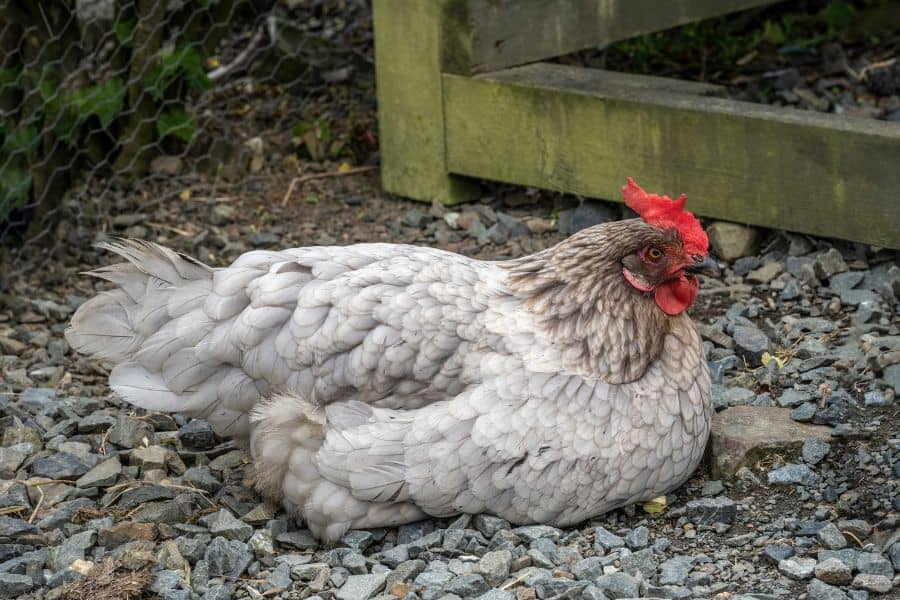
According to the American Poultry Association (APA), American Bantam Association (ABA), and other international poultry standards of perfection, there are only five chicken breeds classified under the gray color variance.
These include Silkie Bantam, Booted Bantam, Dorking Chicken, Japanese Bantam, and Barbu D’uccle bantam.
Since many more breeds are included every year in the standards, the number can rise. Feel free to check your region’s poultry standards for more gray-colored chickens.
Gray colors are rarer than you may think. Most of the grayest-looking chickens are self-blue, lavender, or silver in color. In this article, you will check out a list of the most popular gray-looking chickens, not only true gray chickens but also the grayest silver and self-blue/lavender chickens.
Summary of Recognized Gray Chickens: Silver & Self-Blue Included
The American Poultry Association (APA) and American Bantam Association (ABA) include the most comprehensive lists of gray chickens, and below are the grayest of them all:
| Breeds | Color – Recognized Variety | Average Weight (lbs.) |
Egg Size | Egg Production (Annually) |
| 1. Barbu D’uccle Bantam | Gray | 1.7 – 2.5 | Small | Low |
| 2. Booted Bantam | Gray | 1.9 – 2.2 | Small | Low |
| 3. Dorking (Bantam and Large Fowl) | Single Comb Gray, Single Comb Silver | Large Fowl: 5.3 – 7.6Bantam: 1.6 – 2.3 |
Large Fowl: MediumBantam: Small |
Medium |
| 4. Japanese Bantam | Gray, Silver Duckwing, Silver Laced | 0.88 – 1.3 | Small | Fair |
| 5. Silkie Bantam (bearded and non-bearded) | Gray | 0.8 – 1.2 | Small | Fair |
| 6. Hamburg (Bantam & Large fowl) | Silver Spangled, Silver Penciled | Large Fowl: 5.0 –6.5Bantam: 1.6 – 2.3 |
Large Fowl: MediumBantam: Small |
Medium |
| 7. Campine (Bantam and Large Fowl) | Silver | Large Fowl: 6+Bantam: 1.6 – 2.3 |
Large Fowl: MediumBantam: Small |
Medium |
| 8. Cochin (Bantam and Large Fowl) | Silver Laced | Large Fowl: 6+Bantam: 1.6 + |
Large Fowl: MediumBantam: Small |
Medium |
| 9. Ameraucana (Bantam and Large fowl) | Silver | Large Fowl: 6+Bantam: 1.6 + |
Large Fowl: MediumBantam:Small |
Medium |
| 10. Araucana (Bantam and Large fowl) | Silver Duckwing | Large Fowl: 6+Bantam: 1.6 + |
Large Fowl: MediumBantam: Small |
Medium |
| 11. American Game Bantam | Silver Duckwing | 1.6 – 2.0 | Small | Fair |
| 12. Dutch Bantam | Silver | 1.2 – 1.7 | Small | |
| 13. Leghorn (Bantam and Large Fowl) | Silver, Rose Comb Silver, Single Comb Silver | Large Fowl: 6+Bantam: 1.6 + |
Large Fowl: MediumBantam: Small |
Medium |
| 14. Modern Game (bantam and Large fowl) | Silver Blue, Silver Duckwing | Large Fowl: 7.5+Bantam: 2.2 + |
Large Fowl: MediumBantam: Small |
Medium |
| 15. Old English Game (Bantam and Large Fowl) | Silver Blue, Silver Duckwing, Blue Silver Duckwing, Fawn Silver Duckwing | Large Fowl: 5+Bantam: 2.3+ |
Large Fowl: MediumBantam: Small |
Medium |
| 16. Phoenix (Bantam and Large Fowl) | Silver | Large Fowl: 5+Bantam: 1.65+ |
Large Fowl: MediumBantam: Small |
Medium |
| 17. Plymouth Rock (Bantam and Large Fowl) | Silver Penciled | Large Fowl: 7.5+Bantam: 2.4+ |
Large Fowl: MediumBantam: Small |
Medium |
| 18. Polish (Bantam and Large Fowl) | Silver – Bearded and non-bearded | Large Fowl: 5+Bantam: 2.0 – 2.6 |
Large Fowl: MediumBantam: Small |
Medium |
| 19. Sebright Bantam | Silver | 1.7 – 1.9 | Small | Fair |
| 20. Wyandotte (Bantam and Large Fowl) | Silver Laced, Silver penciled | Large Fowl: 6+Bantam: 1.7 – 1.9 |
Large Fowl: MediumBantam: Small |
Medium |
| 21. Aseel Bantam | Silver | 2.0 – 2.5 | Small | Fair |
| 22. Cochin Bantam | Silver Laced, Silver Penciled | 13 – 1.9 | Small | Fair |
| 23. Cornish Bantam | Silver Laced | 1.2 – 1.7 | Small | Fair |
| 24. Old English Bantam | Silver Blue, Silver Duckwing, Silver Ginger, Silver Wheaten | 1.3 – 1.6 | Small | Fair |
| 25. Rosecomb Bantam | Silver Duckwing | 1.7 – 1.9 | Small | Fair |
| 26. Welsummer Bantam | Silver Duckwing | 1.5 – 2.3 | Small | Fair |
| 27. Yokohama Bantam | Silver | 1.7 – 1.9 | Small | Fair |
| 28. Ameraucana (Bantam and Large Fowl) | Self-Blue | Large Fowl: 5.5 – 6.5Bantam: 1.2 – 1.9 |
Large Fowl: MediumBantam: Small |
Medium |
| 29. Belgian Bearded d’Anver Bantam | Self-Blue | 1.6 – 2.0 | Small | Fair |
| 30. Belgian Bearded D’Uccle Bantam | Self-Blue | 1.6 – 2.0 | Small | |
| 31. Booted | Self-Blue (Bearded and non-bearded) | 4 – 5 | Medium | Fair |
| 32. Old English Game (Bantam and Large Fowl) | Self-Blue | Large Fowl: 7+Bantam: 1.7 – 1.9 |
Large Fowl: MediumBantam: Small |
Fair |
| 33. Silkie Bantam (Bearded) | Self-Blue (Bearded and non-bearded) | 1.9 – 2.2 | Small | Fair |
| 34. Cochin Bantam | Self-Blue | 1.7 – 1.9 | Small | Fair |
| 35. Dutch Bantam | Self-Blue | 1.3 – 1.5 | Small | Fair |
| 36. Japanese Bantam | Self-Blue | 1.1 – 1.4 | Small | Fair |
| 37. Minorca Bantam | Self-Blue | 1.3 – 1.9 | Small | Fair |
| 38. Modern Bantam | Self-Blue | 1.2 – 1.7 | Small | Fair |
Top 8 Grayest Chickens Worldwide
1. Silkie Bantam
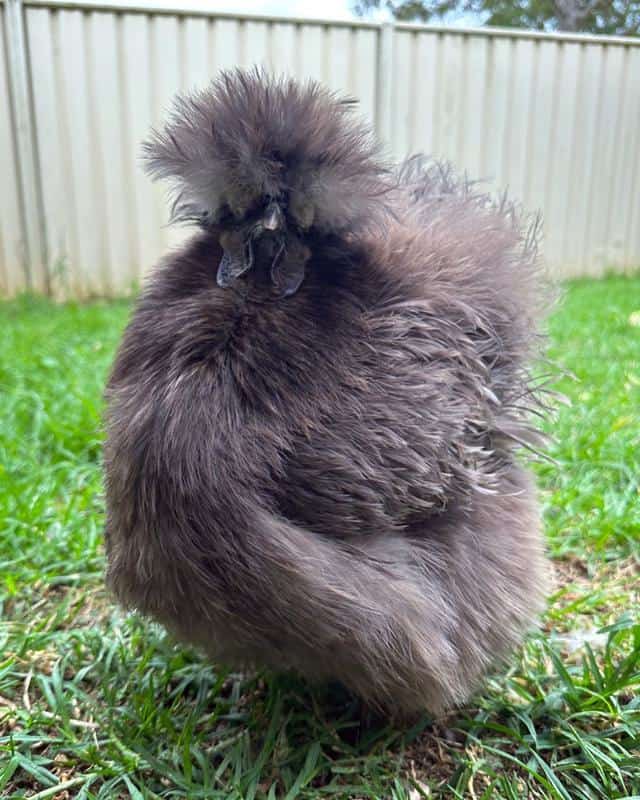
Silkie Bantam chickens are popular ornamental breeds that make for a fun pastime in poultry shows. If you plan to keep them in the backyard, you may also benefit from their natural ability to act as a form of pest control, gobbling up insects wherever they find them.
Since they are bantams, these small chicks lay small eggs (about three eggs per week) and can go all summer, sometimes without laying any eggs.
Silkies come in a wide range of colors, including gray but also black, blue, and buff. The gray bantam is gray laced with a uniform gray coloration spread throughout the body. It
They all feature a fluffy plumage that feels silky and satin. Other unique features include their blue earlobes and five toes on each foot.
When it comes to their temperament, silkie bantams are docile, friendly, and caring, making for great mothers and good playmates for your kids. They go broody often, which can be a disadvantage, but their gray color makes them a unique breed to have around.
2. Booted Bantam/Dutch Booted Bantam
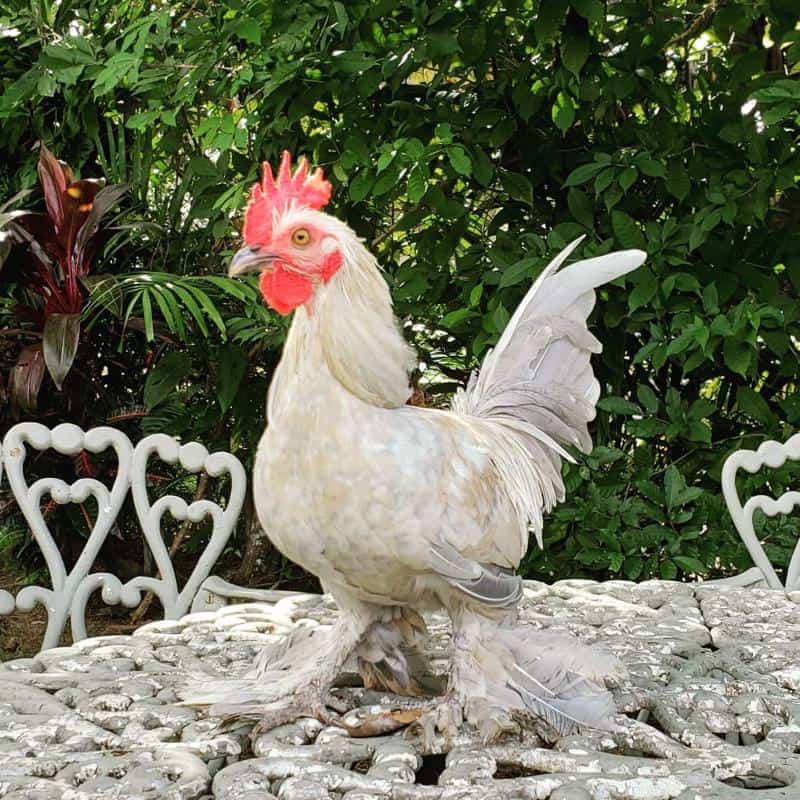
Ranked as one of the most popular bantam breeds worldwide, the Booted Bantam stands as a special breed beloved by keepers for being the ideal pet. Their small sizes and pleasant personalities make them the best chicken breed to give your children as a pet or keep for show.
Booted Bantams are also considered true bantams because, unlike most common bantams that have larger fowl counterparts, the booted bantam is all alone, standing as its own breed without a larger chicken.
The gray-laced bantam has a uniform coloration spread throughout its body. Other recognized varieties include the blue-booted bantam, black, white, and lavender bantam. Essentially, if you are looking for the grayest chicken with lots of gray-looking varieties, then the booted bantam fits the bill with its blue, gray, and lavender chickens.
3. Dorking Chicken
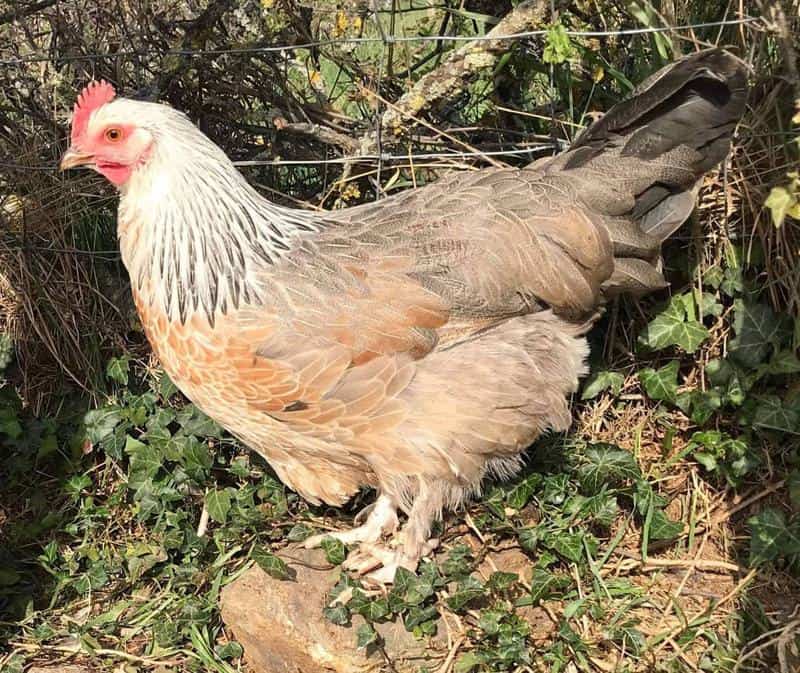
The Dorking Chicken’s most common varieties include red and white. The Single Comb Gray and Single Comb Silver are not as common but are still recognizable variety that adds some beauty to this British breed.
However, it is important to note that this breed is not actually a true gray like the Booted Bantam and Silkie Bantams. It has a combination of silver and black, which can sometimes look gray depending on the shade and distribution.
4. Japanese Bantam
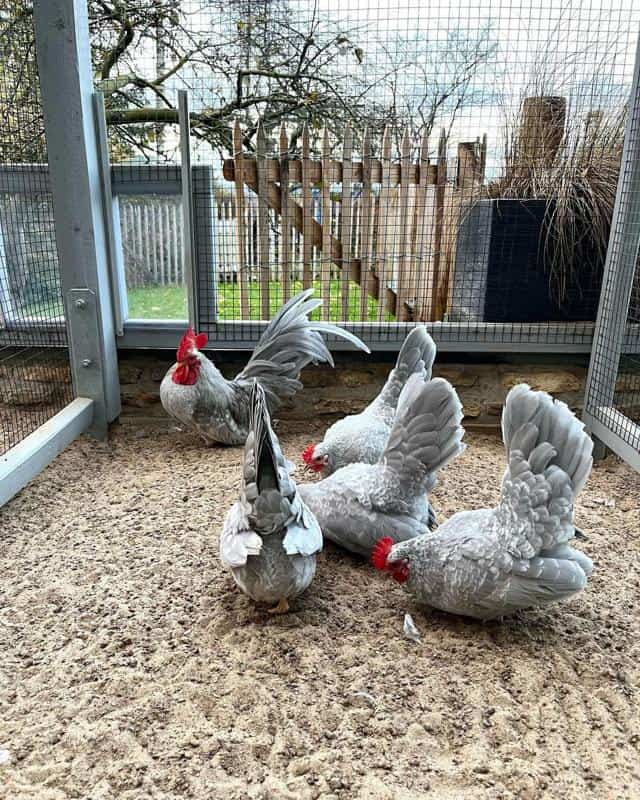
The Japanese Bantam is an ornamental chicken from Japan that comes in different colors, including black, white, wheaten, Gray, Silver Duckwing, and Silver Laced varieties.
It is a small 1.3 lbs. bantam mainly kept for exhibition and also falls under the umbrella of true bantam since it does not have a large fowl counterpart.
Similar to the Dorking chicken, the Japanese Bantam is also gray because of its silver and black coloring.
5. Barbu D’uccle Bantam
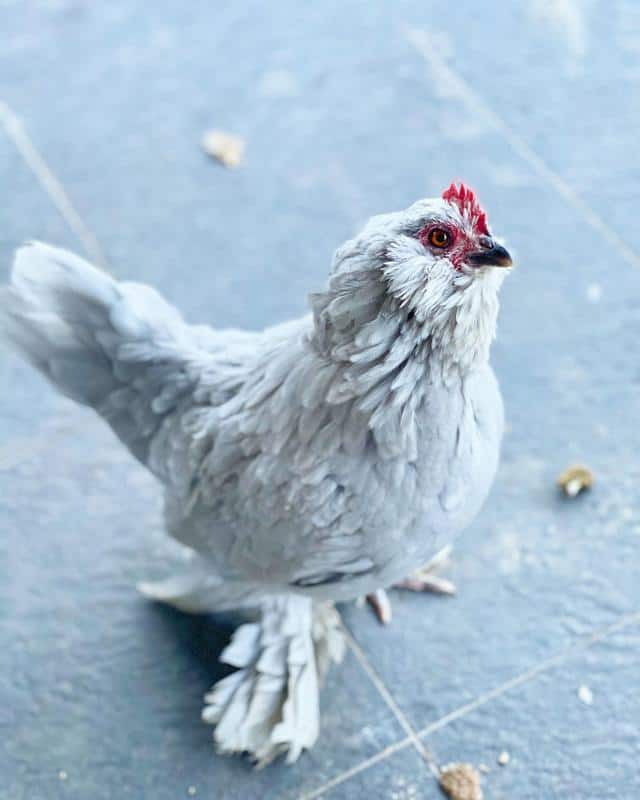
Barbu D’uccle is a Belgian bearded bantam breed with a black, golden neck, mottled, fleur, self-blue, porcelain, and gray variety. In fact, the Barbu D’uccle has about 28 different color varieties that are recognized by the Belgium poultry standards.
The gray Barby D’uccle has a gray-laced body. It also features boots, muffs, and a beard. It is a single-combed and feather-legged breed.
6. Plymouth Rock
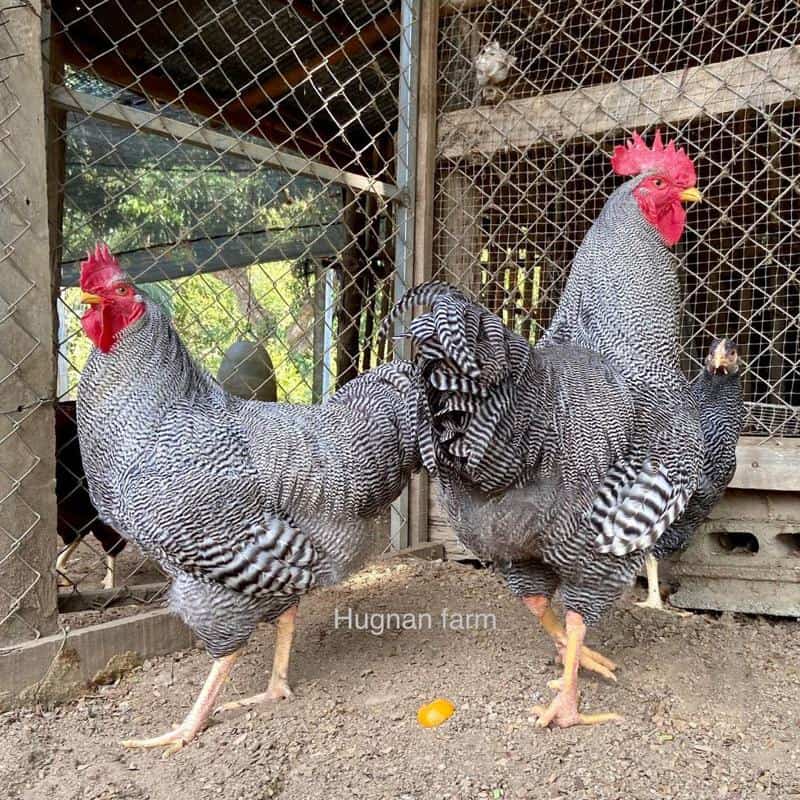
Plymouth Rock is a silver penciled variant with a thick grayish coloration spread across its entire body. The males have silvery necks and backs, plus black breasts, but the females have a more distinct silver-to-gray color.
The single-comb chickens are amazing to look at, with uniform patterns of light and dark gray. The coloration is so beautiful that it makes the chickens a highly-priced option for exhibition purposes and for fly tying.
Variants like the Barred Plymouth Rock have darker blue colors that come out grayish.
7. Self-Blue Ameraucana Chicken
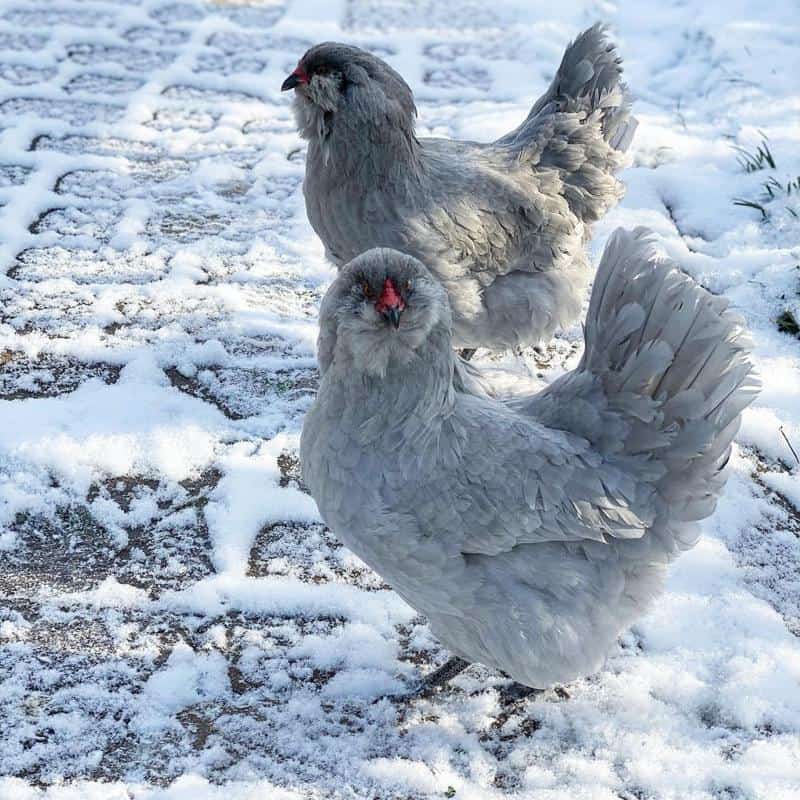
The standard self-blue Americana chickens have beautiful, solid blue feathers throughout their body, creating a striking and uniform appearance. Their blue coloration is often described as a soft, slate-blue shade that can also look gray to many people.
The self-blue Ameraucana is a 1970s breed from the Ameraucana, specifically bred to intensify the color of their blue eggs and increase production. With an average of 200+ eggs per year, the Self-blue Ameraucanas are considered medium-good egg layers capable of serving as production hens.
8. Araucana
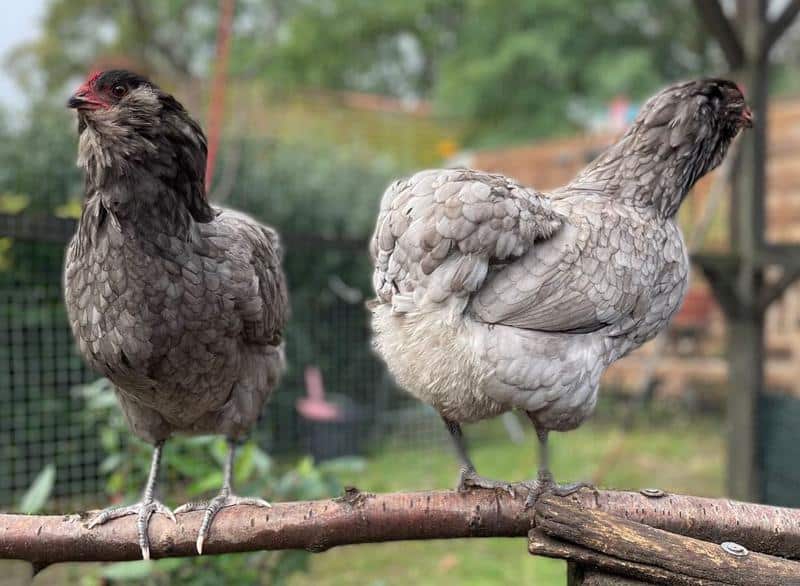
The Araucana is a domestic breed that comes in a wide range of colors, including white, black, and blue. The blue variant has grayish undertones similar to the self-blue Ameraucana chicken. These are rare breeds, but their attractive looks make them a high sort after breed among collectors.
Araucana chicken also produces attractive blue eggs, and with their average-large sizes, they are also kept for meat. On top of that, these breeds have intense black plumage that has been utilized to give rise to many similar-looking crossbreeds.
The native United States’ Easter Egger chicken is an example of an Araucana generation chicken. Easter Egger has an intense gray-looking plumage and was made from a cross between Ameracauna and Aracauna for the purposes of producing blue-shelled eggs.
Other Gray Looking Chickens
Apart from the self-blue chickens, there are other blue-colored chickens that can also appear gray due to varying blue shades produced through vigorous crossbreeding.
Good examples of this include:
9. Gray Australorp
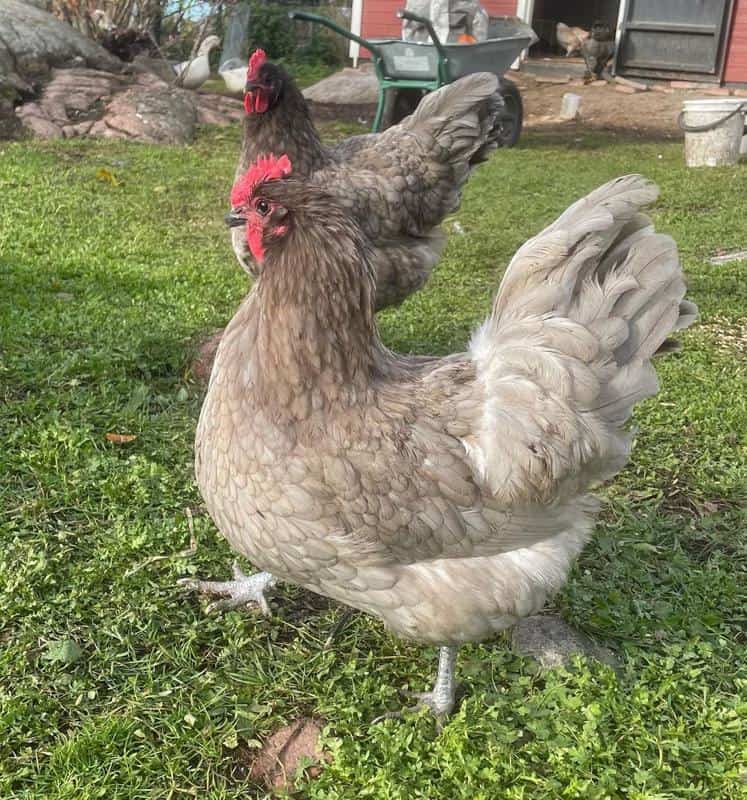
The Australorp breed’s known varieties include the black, white, and blue Australorp. The blue Australorp’s coloration looks gray depending on the shade, hence the ‘Gray Australorp”. Also, due to cross breeding, combination of these varieties can give out a gray looking chicken that most breeders will sell as a gray Australorp variety.
The Australorp is a prolific layer breed from Australian regions. It was developed for egg laying which made it a famous breed for laying more than 300 eggs annually. The eggs are large and brown in color.
Weighing more than 3 pounds, the gray Australorp is a good meat chicken as well and its hardy nature makes it a great investment.
10. Gray Orpington
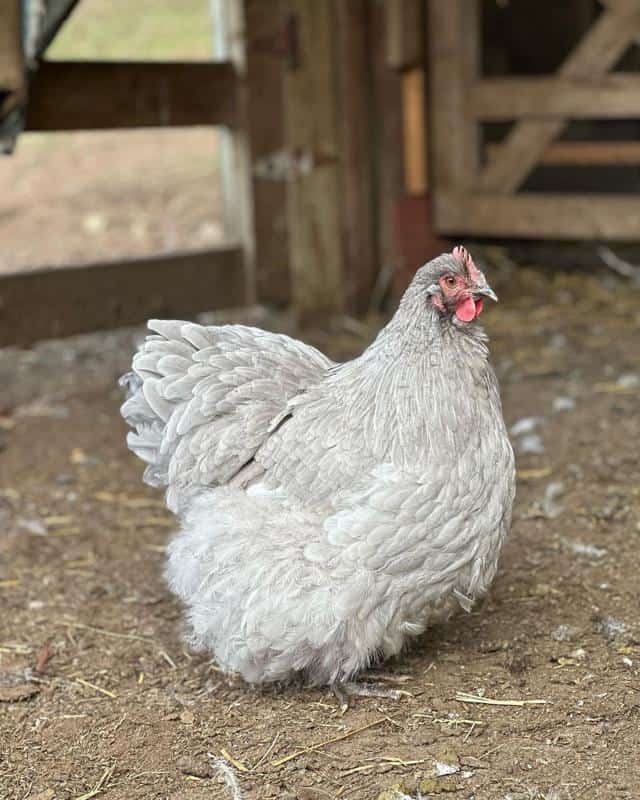
Also known as the Blue Orpington, the Greu Orpington is a domestic chicken known for their affectionate, calm, and quiet temperament. All of these qualities make them the perfect hatchery chicken due to the resulting great maternal instincts.
They are dual-purpose chicken kept for both meat and eggs. They were first developed in Great Britain through a cross of Black Plymouth Rock and the Black Orpington.
Other Gray Orpingtons have been hatched through different crosses including the current varieties which came from a Black and White Orpington from back in 1973.
The lavender looking/gray looking Blue Orpington is among the most famous blue varieties but it is rare to come by. Its coloration ranges from a thick bluish-gray plumage to slate blue with dark purple broad feathers.
11. Sapphire Gem Chicken
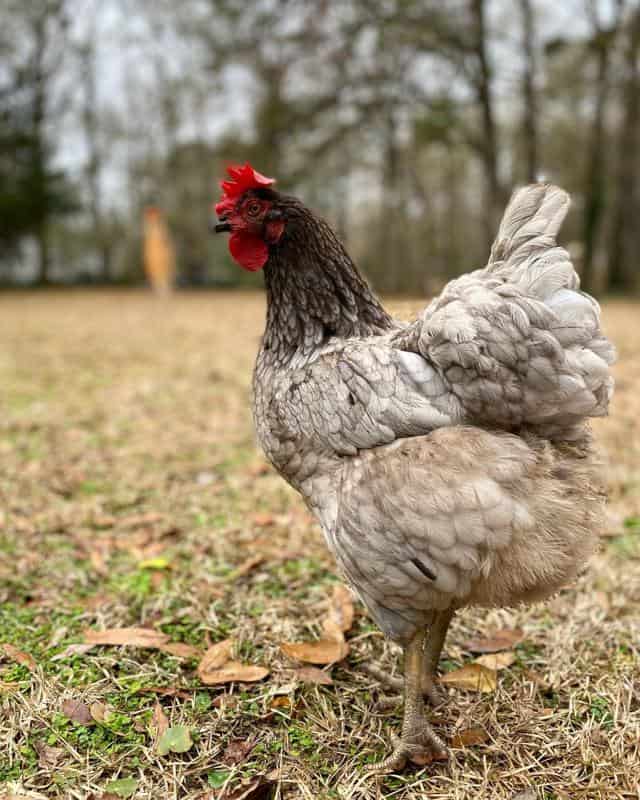
The non-APA-recognized Sapphire Gem Chicken (made from Blue Plymouth Rock and Barred Plymouth Rock) is also known as the Blue Rock or the Sapphire Rocks. It is not to be confused with the Blue Plymouth Rock even though their coloration can be similar.
Sapphire Gems are sex-linked varieties which are as rare in the market, mostly because they are new. Breeding for the Sapphire Gem was first done in Czech Republic giving rise to the breed’s incredible lavender and blue plumage.
Similar to their parents, the Sapphire Gems are good layers with about 290 eggs per year. The eggs are large and brown. Due to their cold hardy nature, the Sapphire Rocks are easy to care for and their medium size makes them good for meat.
Read More: Popular Chicken Colors
How Gray is Formed in Chickens: Genetics of Gray Plumage Colors
1. Self-Blue – Lavender
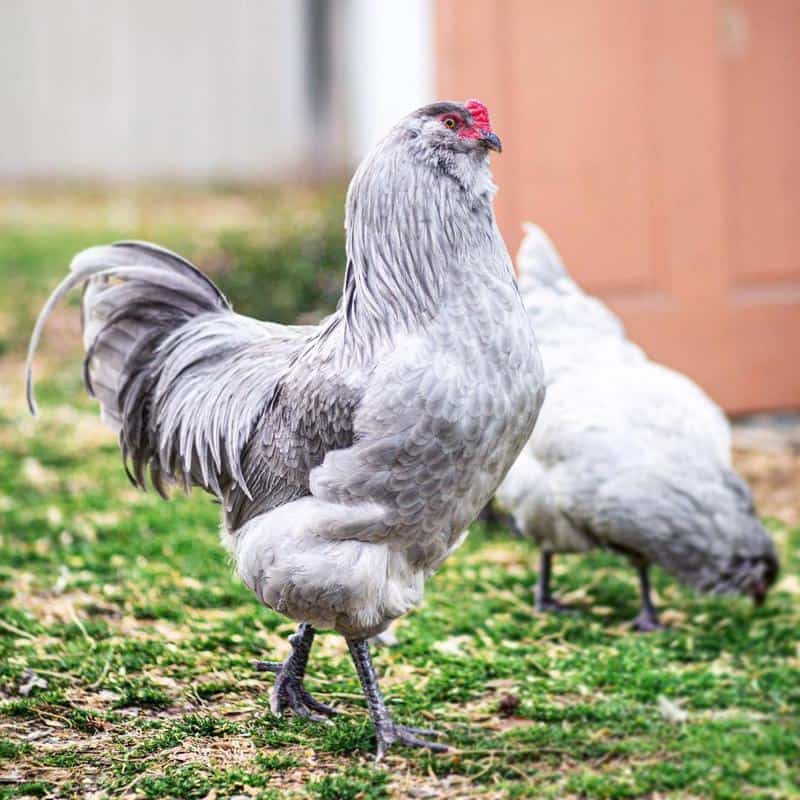
Self-Blue chickens are also called lavender chickens because of the lavender plumage. Lavender is usually not dark or intensely expressed and therefore ends up having a lighter shade which is similar to gray.
Some hatcheries and breeders may refer to these self-blue chickens as gray chickens. Whenever you see breeders refer to self-blue, just know they are talking about lavender chickens instead of true-blue-colored chickens.
Self-Blue chickens come about due to natural breeding among the same species leading to 100% lavender chicks. The chicks will also grow to give birth to 100% lavender chickens because these breeds lack the black and “blue dilution” gene variations that give rise to blue, black, and splash variants.
2. Through Genotypes
Gray chickens acquire their gray colors through specific genetic factors that influence the expression of pigments in their feathers. The primary genetic trait responsible for the gray coloration in chickens is known as the “blue dilution” gene.
The blue dilution gene acts by diluting the black pigment in the feathers of chickens. This dilution effect results in the appearance of gray or silver plumage. The extent of dilution can vary, leading to variations in shades of gray among different gray chicken breeds.
The silver gene is an incomplete dominant gene, meaning that its expression can vary depending on the presence or absence of other genes.
When a chicken carries two copies of the silver gene (homozygous), it will display a more pronounced dilution of black pigment, resulting in a lighter shade of gray.
On the other hand, if a chicken carries only one copy of the silver gene (heterozygous), the dilution effect may be milder, resulting in a darker shade of gray.
In addition to the silver gene, other genetic factors and patterns can influence the appearance of gray plumage in chickens.
For example, barring and lacing patterns can interact with the silver gene, creating unique feather patterns within the gray coloration. These patterns can enhance the aesthetic appeal and variation within gray chicken breeds.
Selective breeding techniques are often employed by breeders to produce and refine specific gray chicken varieties.
By carefully selecting and mating chickens with desired traits, breeders can control and enhance the expression of the silver gene and other associated genetic factors, resulting in the development of distinct and visually appealing gray chicken breeds.
Conclusion
Gray chickens are rare breeds that can be a fun addition to your flock if you intend to spice up the colors of your chickens. They are harder to come across than other colors like black, white, and red, but they hold enticing genetic markers that will pay off if you plan to breed.
All in all, you will not go wrong with any of the gray-colored chicks on this list. If you are looking for more options, then you may want to check your region’s poultry association to see if they have more gray chicken variants.
